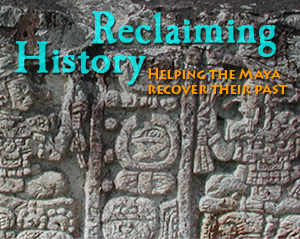Helping the Maya take back their history
CAS professor wins grant to reconnect native people with their cultural heritage

In a river valley in western Honduras, the forest gives way to the Maya ruins of Copan, enormous sculptures, ornate stone altars, and staircases carved with hieroglyphs dating back more than a millennium. Thousands of tourists visit every year and spend their money on tour guides, hotels, and restaurants based in a nearby town of quaint cobblestone streets, white stucco buildings, and red-tiled roofs, a place so tied to the ruins that its name is Copan Ruinas.
The irony, according to Patricia McAnany, a College of Arts and Sciences professor of archaeology, is that thousands of Maya people, whose ancestors carved the sculptures, worshipped at the altars, and built the staircases, live close by, up in the hills. But they don’t live in Copan Ruinas — they can’t afford to — nor do they much share in its prosperity.
It’s a similar story at other well-known and not-so-well-known sites of Maya ruins across Central America. Centuries of dominance by people of European ancestry have cut off the Maya people from their cultural heritage and made many archaeological sites vulnerable to looting. But there’s a growing movement among the Maya, local and foreign archaeologists, and others to redress this situation. McAnany has joined the effort with the help of a three-year grant of about $500,000 from the Wallace Research Foundation to develop projects to reconnect the Maya with these sites, both psychologically and economically, to help them gain the know-how and influence to become stewards and beneficiaries of their archaeological legacy.
The first step was to find out what types of projects were needed and could be sustained locally. So last fall McAnany and two archaeology graduate students, Satoru Murata (GRS’07) and Shoshaunna Parks (GRS’08), visited the five countries of the Maya region — Mexico, Belize, Guatemala, Honduras, and El Salvador — to interview Maya leaders, other archaeologists, and government officials.
“The goal was to find out what is working and what is not working,” says McAnany. “We also wanted to determine the severity of the looting, to evaluate to what extent the descendant Maya communities adjacent to archaeological sites are benefiting from, or being impacted by, archaeological research and tourism development.”
McAnany’s team wrapped up the interviews this spring. What they learned, according to Parks, was that “more than anything, what we can do is use education.” Maya children often aren’t taught much about their ancestry or the related archaeology, or they’re taught just about the major, well-preserved sites like Chichen Itza in Mexico. Meanwhile, new archaeological findings are often reported only in academic journals, leaving Maya communities ignorant of the significance of what’s around them.
Nevertheless, there isn’t a single Maya culture that can be neatly worked into a series of lesson plans. The several million Maya people in Central America represent many distinct cultural and language groups, a diversity McAnany’s team hopes to accommodate when it hosts a conference of educators from all five countries of the Maya region in Mexico this fall to begin designing curriculum materials.
That won’t just be about schoolbooks, says McAnany. “We’re very interested in developing children’s museums and other ways to make it fun, interesting, and exciting to explore the Maya heritage,” she says. The hope is that education will help foster a sense of stewardship, although McAnany acknowledges that won’t be enough in many poorer Maya communities, where the first concern is often putting food on the table or getting proper medication.
Indeed, poverty drives some Maya to loot nearby archaeological sites, either independently or at the behest of so-called arqueo-traficantes, who smuggle valuable pieces to North America, Europe, and Japan, where they often end up in the hands of wealthy collectors or the occasional museum.
“It’s not enough to say, well, these are your ancestral sites so you’d better take care of them, especially when people can’t get enough to eat,” says McAnany. “There have to be different economic incentives in terms of tourism development or some way in which an economic benefit can accrue to people in return for caretaking a site.”
One idea is to train more Maya to be tour guides of local archaeological sites. Another is to take an inventory of the Maya archaeological legacy. Hence, the BU archaeologists have also started assembling a searchable computer database of all Maya archaeological sites in Belize, including maps and detailed information about special features, land ownership, the extent of looting, tourism, and connections to public records or library holdings about each.
Working with the archaeologists is a Belizean environmental consulting firm called Ecoworks, which will use both site visits and satellite imagery to search for and document every site of archaeological significance in Belize.
In addition to Ecoworks, McAnany and her team want to develop partnerships with other local companies and nongovernmental organizations, many of which are already doing similar work to empower Maya communities.
“Building capacity means giving a local population the ability to maintain a project so that as soon as the funding runs out, the project doesn’t come crashing down,” says McAnany.
“What needs to be done is to get people connected to these sites, so that they understand that all of these sites are aspects of their history,” adds Parks. “These sites are everywhere, and they’re part of the modern world just as they’re part of the ancient world.”